How to Poop & Pee When Boondocking
Here are all the ways road nomads handle #1 and #2 when living in their vehicles on public lands...
The question of pooping and peeing when living on public lands is often asked, particularly when one is living in an RV, van, or car, and it’s in the middle of the night. Here’s a look at the various ways other boondockers handle the situation of #1 and #2…
RVs Have Their Own Toilets - The biggest question here is where to dump your gray tank and black tank, and how often. Full waste tanks are the biggest reasons why boondockers have to pack up camp and move out. Most 20-gallon waste tanks can last veteran boondockers a couple of weeks, but lesser experienced persons and couples will fill it up in one week, forcing them to leave camp earlier than hoped.
Most RV parks will let you dump your waste, even if you’re not staying there. They’ll often just charge you between $10.00 to $15.00 to dump your sewage and refill your freshwater tank. Nearly all national parks have dump stations which you can use for free, although you have to pay an entrance fee to get into the park. If you hold an Interagency Pass, which is a federally issued card negating entrance fees, then there’s no charge.
Cartridge Toilet - This is the most popular solution for campers who want to take care of business inside their vehicle. Often called the “Camper Potty”, it looks like a toilet and operates like one, only smaller. It has a waste tank that holds anywhere from 3 gallons to 6 gallons depending on the make and model. The name “cartridge” applies because the tank slides in and out like a cartridge and can remain sealed closed until you dump it at a rest area toilet, or other public restroom.
The advantage to these is that they are lightweight, small, and easily fits into a car or van. They trap odors “fairly” well, but when used with splash of camping toilet enzymes, you can’t smell anything. Camco and Thetford are the top selling brands and can be purchased at Walmart or Amazon anywhere from $80.00 to $100.00.
Composting Toilet - These became popular in the 1970s when gardening hobbyists wanted to grow food with their own poop. Somehow, road nomads came up with the idea that these are environmentally friendly. They are not! It takes anywhere from six to twelve months before biohazards have fully neutralized through decomposition, and campers don’t have that long to carry their waste with them. Yet, the composting toilet industry has seen explosive growth thanks to full-time RVing. Most composting toilets are too big and too heavy for a car or SUV. They require at least a van or RV.
To properly use a composting toilet, you’ll need to add wood shavings into the bottom of the tank. The tank MAY ONLY be used for poop. You still must pee elsewhere, or into a separate tank, which most composting toilets have. Many people just dump the waste into a trash dumpster, which is legal in most US cities and counties. Dumping on the ground, however, is illegal. Odors are a problem with composting toilets, as are with flies. But most of the expensive brands have clever solutions for that. Prices can range from $250.00 for something cheap, up to $1,200.00.
The 5-Gallon Bucket - You’d be quite surprised how many campers are pooping in these! So much so, that many manufacturers are making toilet seats designed to fit on a bucket. Some companies are selling entire kits that come with a bucket, seat, plastic bags, wood shavings, and a roll of toilet paper. You can also buy a pool noodle, slice it down the middle, and line the top of the bucket to act as a seat. Amazon sells all sorts of potty-products designed for 5-gallon buckets.
To use a 5-gallon bucket, first line it with a plastic bag. In fact, double-bag it! Throw some wood shaving in the bottom to help absorb the moisture. Note, it’s not the poop that smells but the moisture in the poop. It helps to add a splash of enzyme to neutralize the odor. You can buy this enzyme at Walmart; all of their full-size stores have an RV section where you can find it. Make sure to remove the bag and tie-off before driving, you don’t want that thing to tip over.
Dig a Hole - This is actually what federal agencies are advising campers to do. They recommend digging a hole at least six inches deep, and then just let it all out. They do not recommend tossing in toilet paper. Remember to fill in the hole!
Digging a hole, however, is meant only for one-time use. It’s illegal to use this method for dumping in gallons of raw sewage, which negates what many composting toilet users were hoping to do. Also, you cannot dig a large hole and leave it open for multiple uses. You wouldn’t want to do that anyway because of the flies.
If you plan to use this method, do yourself a favor at get a proper shovel, not a large one, just something small enough to fit in your vehicle but large enough to throw your weight on. Do not buy a gardening trowel! There are some pretty solid grounds out there networked with roots and rocks, and you don’t want to dig for 15 minutes when you’ve got something knocking on the door.
Smart boondockers will dig a few holes in advance.
Toilet Tents - This is a tent designed to house your camping toilet. It’s meant to give you privacy when camping in places with people nearby. They’re pretty cheap, Amazon sells them for $30.00 to $80.00.
The biggest problem with these is that they blow over easily. When boondocking, you will always encounter strong winds. And these toilet tents are narrow with high profile. Contrast that to a sleeping tent which is wider with a lower profile. Sleeping tents hold up better in strong winds, whereas toilet tents struggle.
This is where you want to read reviews. Look for toilet tents with strong poles and reinforced anchors for staking. Don’t use the thin tent stakes that come with these tents, always buy heavy-duty tent stakes.
What Do You Do With All the Used Toilet Paper?
That’s what the campfire is for!
Boondocking Sites of the Week
(Note: Visit our boondocking map to see more free campsites)
Soap Creek, Marble Canyon, BLM, Vermilion Cliffs, AZ, (GPS: 36.7526, -111.7176), This is a beautiful location for boondocking offering you close access to Marble Canyon, Vermilion Cliffs, and Lee’s Ferry. Boondocking can be hard to find in this area due to heavy tourism, but the turn-over rate is pretty high. Just plan to get here during mid-week, Monday through Thursday, before the evening. Read the full review.
Firehole Canyon Beach, Ashley National Forest, Flaming Gorge, WY, (GPS: 41.3484, -109.4525), Nestled inside the northern portion of Flaming Gorge NRA, you get to enjoy peace and quiet away from the more popular southern portion. However, expect absolutely zero cell signal here. Beautiful views of limestone formations and the sounds of hawks echoing off the canyon walls await. There’s a developed campground nearby with a dump station. Read the full review.
Sidewinder Road, BLM, Ogilby, CA, (GPS: 32.8173, -114.7948), The desert region of Southern California swells with snowbirds every winter, and this boondocking area along Interstate 8 is where many of them flock. With miles and miles of boondocking, there’s enough available space for hundreds of RVs, if not thousands. Free water is available at Sand Hills Rest Area, and a dump station is at the Chevron Station on the Interstate. Watch the full review.
How Likely Will You Get Attacked by Wild Animals When Boondocking?
Probably the most common wild animals you will encounter while boondocking are squirrels, birds, and deer.
Certainly, bears, coyotes, wolves, mountain lion, are all out there, but rarely does anyone get attacked by one when camping. We’ve seen plenty of bears while driving, but never has one approached our campsite.
Probably the most dangerous animal you should watch out for are snakes. Even though snakes have crawled into peoples’ camps before, we’ve never had that happen, nor have we heard from someone who has. If you’re camping in the desert, you probably won’t see a rattlesnake because it’ll be in the colder months that you’re there and because rattlesnakes hibernate.
With regards to bears, it’s largely only black bear you’ll encounter, and they are just not known to attack humans, unless you’re taunting them or hitting them. Grizzly are largely only in Canada and Alaska, with enclaves existing in Yosemite National Park, Yellowstone National Park, and some isolated areas in northern Idaho and Montana.
Learn more about using Bear Spray.
Coyotes are everywhere but do not attack humans, and in fact will stay away from your camp. You’ll hear them often. Just keep your dog on a leash and your cat inside.
Mountain lions, however, do attack people. But they’re only looking for easy prey. If you go out hiking, go with another person. We’ve not heard of mountain lion entering a campsite, though it could happen if you leave a child unattended.


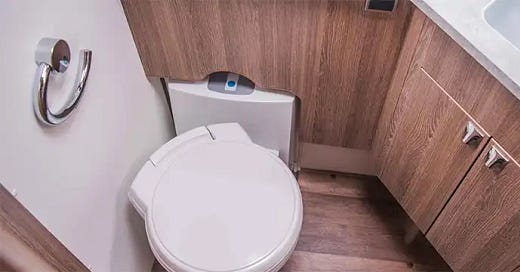



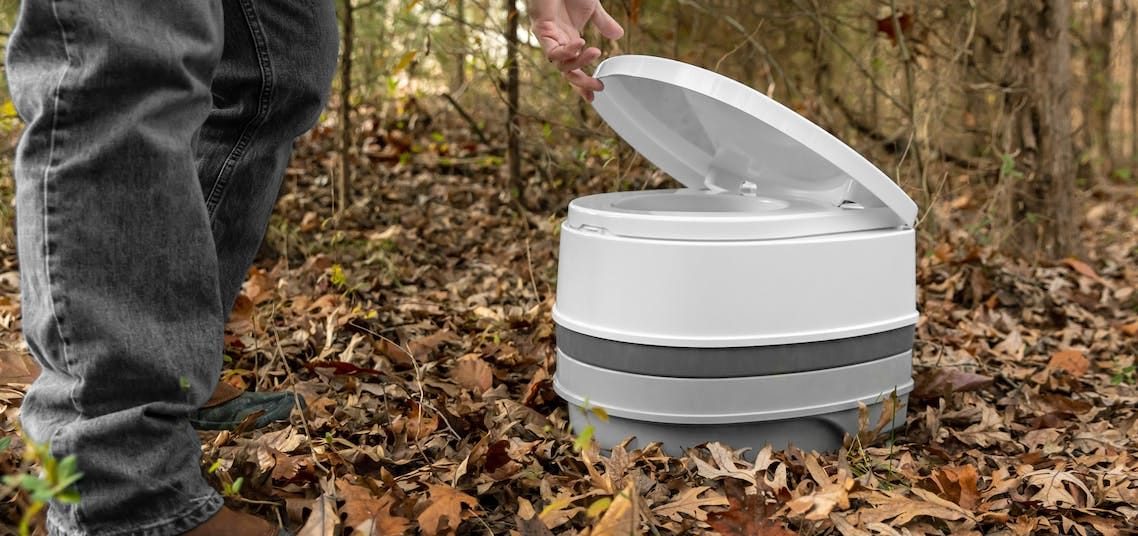
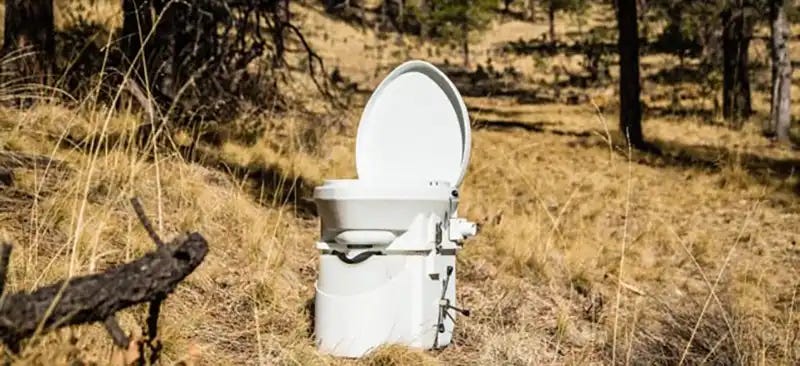
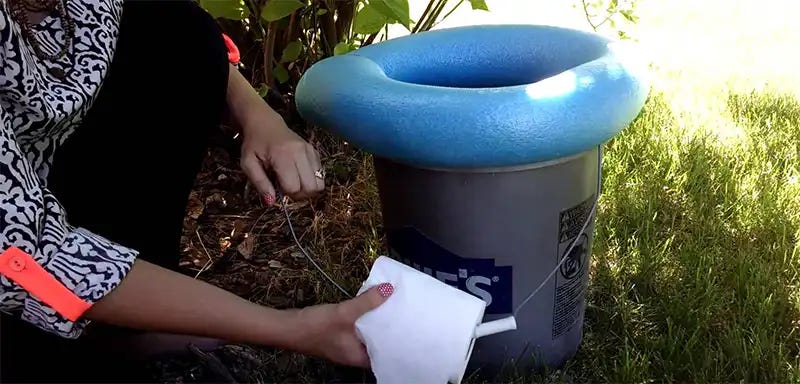
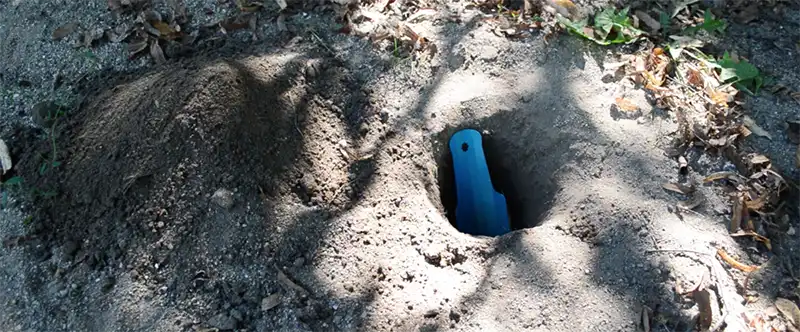
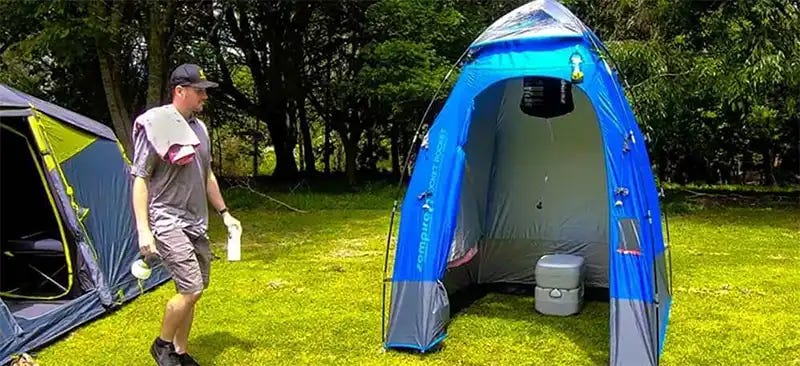



Folks! I use an Earth Head composting toilet. Please allow me to clear-up some misconceptions in this article. Maybe the information is old, but now:
1) You CAN in fact pee into the Earth Head. Mechanically we are built to pee out ahead of ourselves at least a bit. This separates the pee and stores it in a large bin.
2) For ultimate results in the poop factory bin, dry or moist peat moss, but coconut fibers works the best! The agitator (not political), grinds the poo into the peat/coconut fiber and does its biological trick.
3) NO ODER! I'll say it again....."NO ODER!"
The modern Earth Head unit is equipped with an Uber-low current vent fan that keeps a constant negative ventilation going, during the exhaust outside the van via a simple hose.
If you are a single, you can expect to empty the pee bin about every 4th day, and change the compost every 9-weeks. BOTH are super easy, and NOT gross at all. I will NEVER have a black water tank in my life. BW Tanks are insane once you know and have experienced a Composting Toilet.